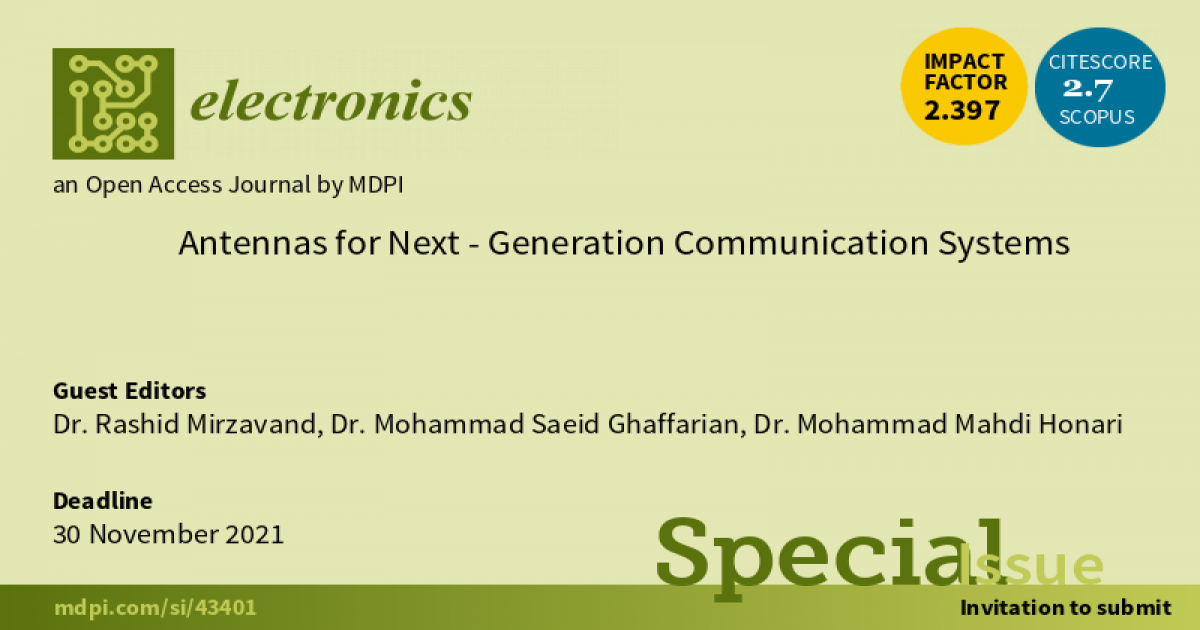Antennas for Next-Generation Communication Systems
A special issue of Electronics (ISSN 2079-9292). This special issue belongs to the section "Microwave and Wireless Communications".
Deadline for manuscript submissions: closed (30 November 2021) | Viewed by 43694

Special Issue Editors
Interests: wireless communications; Internet of Things; intelligent sensors; microwave/mm-wave circuits; integrated antennas for 5G
Interests: metamatiral antennas; phased array antenna; very compact antennas; RF/microwave circuits
Interests: RFID/microwave sensors; integrated circuits for 5G; surface modulated antennas; active integrated antennas; RF/microwave circuits.
Special Issues, Collections and Topics in MDPI journals
Special Issue Information
Dear Colleagues,
Low-cost and compact antennas and communication systems are being developed to support the increasing demand for wide bandwidth in next generation wireless communication networks (5G) and/or the Internet of Things (IoT). To achieve reliable, high data rate communication links, various methods have been introduced to enhance the directivity of planar antennas, enabling the next generation of high frequency and wireless communication. Considering the current attempts to apply 5G technology in the public market, such as in smart phones or smart city applications, the major concern is the ability to satisfy the fast rise in user and traffic capacity in mobile broadband communications. Therefore, smart antennas with intelligent beamforming capability have an important role in these areas. The purpose of this Special Issue is to present the latest technology and developments in antennas for the next-generation of communication systems. All researchers in the field are invited to contribute their original, unpublished works. Both research and review papers are welcome.
Topics of interest include but are not limited to:
- Smart antennas:
- antenna array design;
- MIMO antennas;
- multi beam antenna systems;
- integrated phased array antennas;
- antenna array optimization;
- antenna calibration method;
- channel modeling
- Special, compact, and/or low-cost antennas:
- green antennas;
- sensor antennas;
- terahertz planar antenna;
- miniturized antenna for IOT systems;
- very compact antenna for navigation systems;
- transparent antennas;
- intelligent antennas;
- ultra wideband (UWB) antennas;
- RFID antennas;
- energy havesting antennas
Dr. Rashid Mirzavand
Dr. Mohammad Saeid Ghaffarian
Dr. Mohammad Mahdi Honari
Guest Editors
Manuscript Submission Information
Manuscripts should be submitted online at www.mdpi.com by registering and logging in to this website. Once you are registered, click here to go to the submission form. Manuscripts can be submitted until the deadline. All submissions that pass pre-check are peer-reviewed. Accepted papers will be published continuously in the journal (as soon as accepted) and will be listed together on the special issue website. Research articles, review articles as well as short communications are invited. For planned papers, a title and short abstract (about 250 words) can be sent to the Editorial Office for assessment.
Submitted manuscripts should not have been published previously, nor be under consideration for publication elsewhere (except conference proceedings papers). All manuscripts are thoroughly refereed through a single-blind peer-review process. A guide for authors and other relevant information for submission of manuscripts is available on the Instructions for Authors page. Electronics is an international peer-reviewed open access semimonthly journal published by MDPI.
Please visit the Instructions for Authors page before submitting a manuscript. The Article Processing Charge (APC) for publication in this open access journal is 2400 CHF (Swiss Francs). Submitted papers should be well formatted and use good English. Authors may use MDPI's English editing service prior to publication or during author revisions.
Keywords
- 5G
- active
- antenna
- array
- compact
- device-to-device (D2D) communications
- green technology
- IoT
- MIMO system
- microwave
- mm-wave
- phased array
- rectenna
- RFID
- sensor
- smart
- wireless
Benefits of Publishing in a Special Issue
- Ease of navigation: Grouping papers by topic helps scholars navigate broad scope journals more efficiently.
- Greater discoverability: Special Issues support the reach and impact of scientific research. Articles in Special Issues are more discoverable and cited more frequently.
- Expansion of research network: Special Issues facilitate connections among authors, fostering scientific collaborations.
- External promotion: Articles in Special Issues are often promoted through the journal's social media, increasing their visibility.
- Reprint: MDPI Books provides the opportunity to republish successful Special Issues in book format, both online and in print.
Further information on MDPI's Special Issue policies can be found here.







